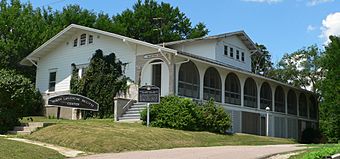Dr. Susan LaFlesche Picotte Memorial Hospital facts for kids
|
Dr. Susan Picotte Memorial Hospital
|
|

Front of the hospital
|
|
| Location | 503 Matthewson St., Walthill, Nebraska |
|---|---|
| Built | 1912 |
| Architect | William L. Steele |
| Architectural style | Craftsman |
| NRHP reference No. | 88002762 |
Quick facts for kids Significant dates |
|
| Added to NRHP | December 16, 1988 |
| Designated NHL | April 19, 1993 |
The Dr. Susan LaFlesche Picotte Memorial Hospital is a historic building in Walthill, Nebraska. It is also known as Walthill Hospital. This important hospital is located on the Omaha Reservation.
The hospital was started by Dr. Susan La Flesche Picotte (1865–1915). She was the first female Native American doctor. Dr. Picotte raised money to build this hospital. It was the first hospital on any Native American reservation that was not paid for by the government. The hospital served the community until the 1940s. Since then, it has been used for many other things. In 1993, it was named a National Historic Landmark.
About the Hospital Building
The Picotte Hospital building is on the west side of Walthill. It is found on Matthewson Street. The building was designed by architect William L. Steele in 1912. It was built between 1912 and 1913.
The hospital is one and a half stories tall. It sits on a concrete foundation on a hill. The building was made in the American Craftsman style. This style often has a low-pitched roof. It also has wide eaves and exposed roof rafters. A large screened porch runs along the front of the building. Columns support the roof of this porch.
The Story of Dr. Susan LaFlesche Picotte
Susan LaFlesche Picotte was born in 1865. She was a member of the Omaha tribe. Her father, Joseph LaFlesche, was the last chief of the tribe. He made sure his children received a good education. He wanted them to be able to live well in white society.
Susan studied medicine at the Woman's Medical College of Pennsylvania. After finishing her training, she returned to the reservation. She soon became the main doctor for the community. She worked hard to raise $8,000 to build the hospital. This money came from different private groups.
The building worked as a hospital until the late 1940s. After that, it was used for many different purposes. At one point, it was even a museum. In 2013, it housed Mi'Jhu'Wi Ministries. This group helps people on the Omaha Reservation.



